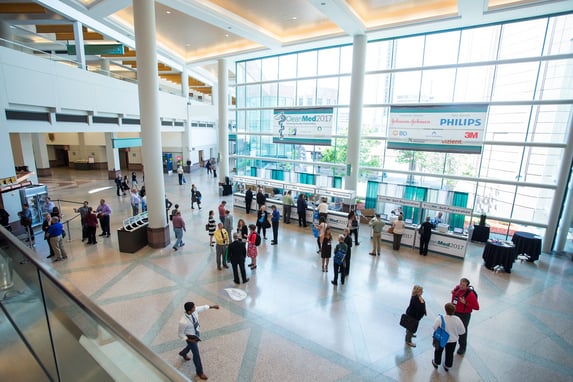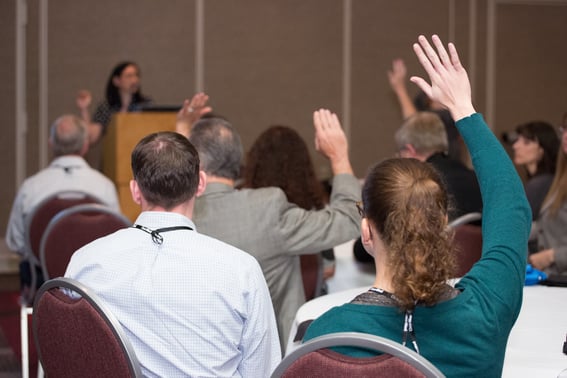I recently attended the CleanMed Conference and Exposition in Minneapolis, Minnesota. This event, organized by Health Care Without Harm and Practice Greenhealth, “has gained a global reputation as the premier conference on environmental sustainability in the health care sector.”[1] This blog post will discuss the conference content as well as a few key points from several of the workshops I attended.

Photo by Event Photography of North America Corporation
Conference Audience
This conference and exhibition provides workshops which cover many different areas of health care that can have impacts on the environment, such as energy and water usage, climate, operating room processes, food, green design for new construction and renovations, waste and recycling programs, and purchasing supplies. The presenters for the workshops are the industry leaders and experts in their specific field of expertise. The environmentally friendly practices that are discussed have been used and tested, in most cases successfully. The audience included health care employees (from ALL departments), health care vendors, as well as engineers - just to name a few.

Photo by Event Photography of North America Corporation
Climate change and the health care industry’s effects on our environment were discussed heavily during the first day of this conference. We heard from individuals who have acted on committing their life work to changing the way we do things to minimize our impact. These speeches were inspiring and had a noticeable impact on the audience.
Workshops
The following workshops I attended are related to energy and green building design and construction:
- Energy Management at Mayo Clinic: This presentation focused on the energy management program at Mayo Clinic in Rochester, Minnesota. I was impressed with their approach and strategy for reducing energy consumption (goal of 20% reduction by 2020). At the end of 2016, the organization reported a 16% reduction from their baseline (WOW!) and saving $4 million per year. The following are some of the key points from this workshop:
- A crucial means of success for a goal like this is to have high engagement from facilities staff as part of the process. They are the ones who understand the systems and need to provide input. They are also the ones who must work with the systems after they are handed over.
- Because their portfolio is mostly existing buildings, “retrocommissioning is their primary tool” to reach their goal. Depending on the building size, this process was either consultant led (larger buildings) or in-house with consultant support (smaller buildings).
- Their high value opportunities include fume hood controls (labs), duct sealing, and OR HVAC scheduling, just to name a few.
- The organization has put their focus on the conservation effort, not renewables.
- Green Hospital Programs in South Korea: This presentation described the green hospital program developed for the Yonsei University Health System located in Seoul, South Korea. It was very interesting to hear about the challenges they encountered while developing this program and how different they are then what we encounter in the USA. Some key take-aways from this are:
- Many of the energy reduction measures mentioned are very similar to what we do in the USA, including temperature setbacks through the BMS and installing high efficiency equipment. Additionally, the presenter discussed using escalator power saving mode as well as installing low E-glass.
- China is following the South Korea program.
- One challenge that was mentioned is the low level of understanding among healthcare workers regarding implemented measures. As a means of providing information to the staff, they have started posting posters around the hospital outlining energy savings.
- High Performance Design from Start to Finish: This workshop reviewed in detail the integrated approach process, from RFQ/RFP through design, construction, and operations for achieving high performance health care in new construction. There were several key points from this workshop:
- During the RFQ/RFP process, energy modeling is a piece that is sometimes overlooked. It’s very important to indicate the specifics for what is required (how many models are needed and how often is this updated?).
- The EPA is developing guidelines for energy efficient medical equipment.
- The presenters explained the importance of commissioning and described the use of “optimized commissioning” which is more than just testing per the design. It includes making changes that are outside of the design and always looking for opportunities to improve the performance of the building during the testing process.
Conclusion
I am proud to work with organizations that support changing their processes to better support environmental sustainability in the health care sector. It was a fantastic event and I enjoyed talking to many different people from all over the country who are making strides, especially in energy.
[1] http://cleanmed.org/overview/the-history-of-cleanmed/



